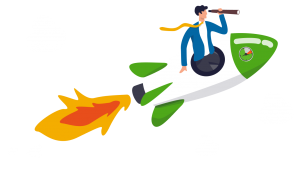Left brain vs. right brain – differences and how to leverage both at work

You’ve probably heard about being a “left-brain” or “right-brain” person in psychology. It suggests that our brain is split into two parts, with each side controlling different aspects of our thinking. The left brain is all about logical, analytical thinking, while the right brain is where creativity, intuition, and emotions thrive.
You might be curious about which side you lean toward – but research suggests that while both sides possess unique strengths, they most often work in tandem.
In fact, The World Economic Forum’s Future of Jobs 2023 report confirms the importance of both analytical thinking and creative thinking. These two skills rank at the top as the most sought-after abilities in today’s workplace.
In this blog post, we will explore the differences between the right and left brain and how they interact in shaping our thinking. We’ll see how a deeper understanding of our brain can lead to better productivity in the workplace.
Want to get the most out of your time?
Try DeskTime for free!
Try free for 14 days · No credit card required.
By signing up, you agree to our terms and privacy policy.

The analytical strength of the left brain
The left brain is all about processing intricate details, handling logical problem-solving, and analytical thinking. It excels at breaking down complex problems into smaller, manageable parts, thriving on systematic analysis and rational reasoning.
When we need to pay attention to detail, the left brain is our go-to hemisphere. It helps us navigate through data, identify key elements, and approach problem-solving with a logical approach.
In the workplace, the left brain empowers us to handle complex projects, make data-driven decisions, and excel in tasks that require attention to detail.
The creative power of the right brain
The right hemisphere of our brain is a creative powerhouse. It’s great for activities like brainstorming and generating fresh ideas. It’s also the part that sees the ‘’big picture’’ and embraces a broader perspective. When we’re being creative, the right brain takes charge, igniting our imagination and intuition.
It gives us fresh perspectives, generates out-of-the-box ideas, and makes connections between seemingly unrelated things. Whether we’re in the realm of art, strategic planning, or envisioning the future, the right brain adds a fresh dimension to our thinking, helping us to find novel solutions.
Right vs. left brain: why it’s not a competition
While the left brain is associated with logic and the right brain with creativity, we shouldn’t assume that thinking itself is one-sided.
Rather than being strictly divided, the functions of the brain involve a variety of processes that may work better on one side than the other. It’s not about one hemisphere completely taking charge of a particular task – instead, it’s more like teamwork between both sides.
Consider the simple act of looking at a house:
The left side helps you recognize the shapes of the doors, windows, and other parts. Meanwhile, the right side helps you see the overall shape of the building. The left side also helps you understand where things are in relation to each other. On the other hand, the right side helps you judge distances more precisely, like how far the window is from the door.
This example shows us that even the simplest tasks require the involvement of both hemispheres of the brain. In other words, the left and right hemispheres are not engaged in competition. They are more like partners – each hemisphere brings its unique strengths and abilities to the table, creating a relationship that makes up our overall cognitive functioning.

Harmonizing both hemispheres: merging purpose and action
When it comes to brain hemispheres, it’s important to recognize that although they have distinct roles, both are equally essential when it comes to work productivity. The left brain is all about finishing tasks and getting hands dirty, so to speak. On the other hand, the right brain craves a broader perspective, meaning, and fulfillment in our work.
The key is to find a way to engage both sides of our brain.
It all starts with understanding the purpose behind any given task – the driving “why” that ignites excitement and motivation in the right brain. From there, we break it down into manageable steps, the practical “how” that stimulates the left brain and propels us into action.
Essentially, it’s about blending broader meaning with hands-on execution – recognizing that both aspects are equally crucial for sustained productivity in our professional lives.
When we disregard the right brain, our tasks may start to feel robotic and devoid of deeper meaning. Conversely, neglecting the left brain hampers our ability to delve into abstract and analytical work.
So, when it comes to the workplace, the question is: how can we make the most of both sides of our brain to enhance our productivity?
Strategies to stimulate both hemispheres at work
Let’s look at some strategies that can help you activate the entire spectrum of your cognitive abilities. By incorporating them into your work routine, you can optimize your brain’s performance and achieve greater productivity.

Take advantage of diverse sources
When faced with various tasks and problems in the workplace, it’s a good idea to leverage a diverse range of sources – both external and internal. By drawing insights from different sources, you can stimulate both sides of the brain and enhance your problem-solving abilities.
For example, let’s say you’re tasked with developing a new product feature for an app. You can start with external input: by researching industry trends, reading case studies, and seeking advice from mentors or experts in the field.
Then, you can tap into your internal resources by reflecting on your own skills and knowledge. You might consider your previous experience in user interface design, your understanding of user behavior, and your familiarity with the app’s target audience.
Embrace interdisciplinary collaboration
You should seek out collaboration with colleagues who possess different strengths and thinking styles. Try to engage in interdisciplinary projects or teams where individuals from various backgrounds can contribute their perspectives. This kind of collaboration encourages the interplay of both hemispheres – as different skills and expertise come together.
A good example is a targeted marketing campaign, which involves a marketing expert, data analyst, and content creator. The marketing expert, using logical and analytical thinking (left brain), ensures the campaign connects with the audience by strategizing based on market trends and audience insights. The data analyst, also employing left-brain thinking, analyzes data to identify patterns. Meanwhile, the content creator taps into their creativity (right brain) to craft engaging content that resonates with the audience.

Engage in skill-balancing activities
Seek activities that stimulate both hemispheres of the brain. If your job primarily emphasizes one hemisphere of the brain, make a conscious effort to engage in activities that leverage the other side.
If your job primarily involves creative tasks, such as graphic design or writing, it’s valuable to explore new skills that demand logical reasoning and structured thinking. For instance, you can invest time in learning data analysis to effectively interpret and leverage data insights for your creative projects. This combination of creativity and analytical thinking can enhance the quality and impact of your work.
Conversely, if your work focuses on number crunching, it’s a good idea to allocate time for creative pursuits. Engaging in brainstorming sessions can foster your ability to think outside the box and generate innovative solutions. You can also try learning graphic design or visual storytelling to effectively communicate your data findings.

Are you ready to maximize your productivity?
Make the most of your time with DeskTime
Concluding remarks: uniting the divide
While some of us may naturally lean more towards one side or the other, we should resist the temptation of labeling ourselves as strictly “left-brain” or “right-brain” individuals.
Rather than viewing them as opposing forces – the left brain vs. the right brain – we should recognize that, in reality, our thinking integrates the entirety of our brains. By embracing the holistic nature of our brains, we can unlock our minds’ full potential and achieve better productivity at work.
Did you find this article useful? Give it a clap!
Psst! You can clap more than once if you really loved it 🙂